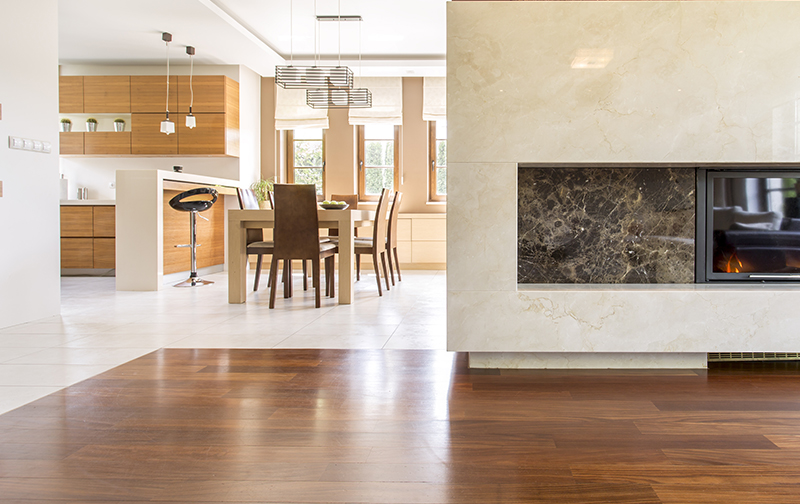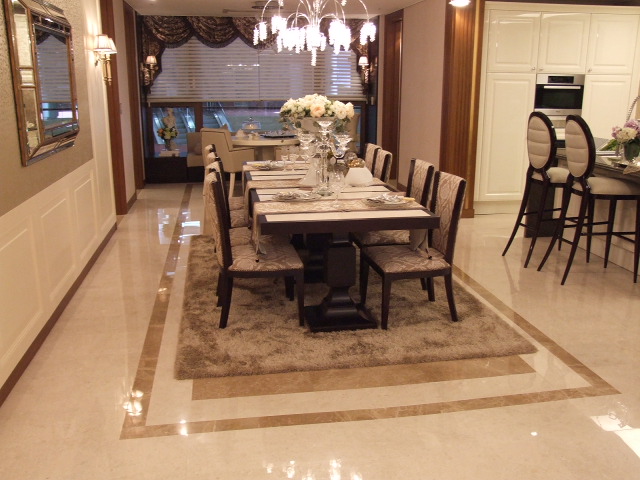Transitioning from wood floors in the dining room to the kitchen can be a challenging task. Not only do you want the transition to flow seamlessly, but you also want it to look aesthetically pleasing. Here are some tips and ideas to help you achieve a smooth and stylish wood floor transition.Wood Floor Transition: Tips and Ideas
When it comes to choosing flooring for your kitchen, wood floors are a versatile and popular option. They add warmth and character to the space, and they are also durable and easy to maintain. Plus, with the right transition, they can seamlessly connect to your dining room for a cohesive look.Wood Floor Kitchen: A Versatile Choice
The dining room is often the heart of the home, where family and friends gather for meals and special occasions. Adding wood floors to this space can elevate the overall look and feel, bringing in a touch of elegance and charm. With the right transition, your dining room can flow beautifully into your kitchen, creating a cohesive and inviting space.Wood Floor Dining Room: Elegance and Charm
When planning your wood floor transition, there are a few important considerations to keep in mind. The first is the difference in height between your dining room and kitchen floors. This will determine the type of transition you will need to use. You should also consider the color and style of your wood floors and how they will complement each other in the transition area.Transition From Wood Floor: Considerations
There are several types of transitions you can use to connect your wood floors in the dining room to the kitchen. One popular option is a T-molding, which is a flat strip of wood that sits between the two floors and creates a smooth transition. Another option is a threshold, which is a raised strip that can also serve as a barrier to keep spills from the kitchen from reaching the dining room.Wood Floor to Kitchen: Types of Transitions
If you want to add a creative touch to your wood floor transition, there are many ideas to consider. You can use a herringbone pattern to create a unique transition zone, or you can use a different type of wood in the transition area for a contrasting effect. Another idea is to use a decorative tile or stone as a transition piece, adding a pop of color and texture to the space.Wood Floor to Dining Room: Creative Ideas
Transition strips are not only practical and functional, but they can also add a decorative touch to your wood floor transition. You can choose from a variety of materials, such as wood, metal, or rubber, and they come in different finishes to match your wood floors. They also come in different widths and lengths to fit your specific transition needs.Wood Floor Transition Strips: Practical and Functional
The transition area between your wood floors in the dining room and kitchen doesn't have to be boring. You can use creative wood floor transition designs to bring style and personality to your space. Consider a diagonal transition, a curved transition, or even a patterned transition to add visual interest and make a statement.Wood Floor Transition Designs: Bringing Style to Your Space
With the endless possibilities for wood floor transitions, you can truly customize the look and feel of your space. Whether you prefer a seamless flow between the two rooms or a more distinct transition, there is an option to suit your style. Don't be afraid to get creative and think outside the box for a truly unique and beautiful wood floor transition.Wood Floor Transition Options: Endless Possibilities
Transitioning from wood floors in the dining room to the kitchen may seem daunting, but with the right tips and ideas, you can achieve a smooth and stylish transition. Consider the height difference, choose the right type of transition, and get creative with your designs. With the right approach, your wood floor transition will be a seamless and beautiful addition to your home.In Conclusion
Creating a Seamless Transition from Wood Floor Dining Room to Kitchen

Merging Two Spaces into One
 When designing a home, it's important to consider how each room will flow into the next. This is especially true for the dining room and kitchen, two spaces that are often connected and used together. One key element in creating a cohesive design between these two rooms is the flooring.
Wood floors
are a popular choice for both dining rooms and kitchens, but how do you seamlessly transition from one to the other? Here are some tips to help you create a smooth and stylish transition from
wood floor dining room
to kitchen.
When designing a home, it's important to consider how each room will flow into the next. This is especially true for the dining room and kitchen, two spaces that are often connected and used together. One key element in creating a cohesive design between these two rooms is the flooring.
Wood floors
are a popular choice for both dining rooms and kitchens, but how do you seamlessly transition from one to the other? Here are some tips to help you create a smooth and stylish transition from
wood floor dining room
to kitchen.
Choosing the Right Flooring
 The first step in creating a seamless transition is to choose the right flooring for both your dining room and kitchen. While
wood floors
are a popular choice, there are other options that may better suit your needs. For example, if your dining room and kitchen are open concept, you may want to consider using the same type of flooring throughout both spaces. This will create a sense of continuity and make the transition between the two rooms less noticeable. Alternatively, you can choose different types of wood flooring that complement each other, such as a lighter color in the dining room and a darker color in the kitchen.
The first step in creating a seamless transition is to choose the right flooring for both your dining room and kitchen. While
wood floors
are a popular choice, there are other options that may better suit your needs. For example, if your dining room and kitchen are open concept, you may want to consider using the same type of flooring throughout both spaces. This will create a sense of continuity and make the transition between the two rooms less noticeable. Alternatively, you can choose different types of wood flooring that complement each other, such as a lighter color in the dining room and a darker color in the kitchen.
Using Transition Pieces
 Another way to create a seamless transition is by using transition pieces. These are strips of flooring that are designed to bridge the gap between two different types of flooring, such as
wood floors
and tile. They come in a variety of materials and styles, so you can choose one that best matches your existing flooring. Additionally, transition pieces can also be used to separate the dining room and kitchen visually, creating a defined space for each.
Another way to create a seamless transition is by using transition pieces. These are strips of flooring that are designed to bridge the gap between two different types of flooring, such as
wood floors
and tile. They come in a variety of materials and styles, so you can choose one that best matches your existing flooring. Additionally, transition pieces can also be used to separate the dining room and kitchen visually, creating a defined space for each.
Blending with Color and Pattern
 One of the most effective ways to create a seamless transition is by using color and pattern. If you have different types of flooring in your dining room and kitchen, you can blend them together by using a rug that incorporates both colors and patterns. This will not only create a cohesive look, but it will also add texture and warmth to the space. You can also use paint to create a visual transition between the two rooms. For example, painting a feature wall in the dining room the same color as the kitchen backsplash will create a sense of connection between the two spaces.
One of the most effective ways to create a seamless transition is by using color and pattern. If you have different types of flooring in your dining room and kitchen, you can blend them together by using a rug that incorporates both colors and patterns. This will not only create a cohesive look, but it will also add texture and warmth to the space. You can also use paint to create a visual transition between the two rooms. For example, painting a feature wall in the dining room the same color as the kitchen backsplash will create a sense of connection between the two spaces.
Adding a Border
 Another creative way to transition from
wood floor dining room
to kitchen is by adding a border. This can be achieved by using a different type of flooring around the perimeter of the dining room, such as tile or stone. Not only will this create a visual separation between the two rooms, but it can also add an interesting design element to your home.
Another creative way to transition from
wood floor dining room
to kitchen is by adding a border. This can be achieved by using a different type of flooring around the perimeter of the dining room, such as tile or stone. Not only will this create a visual separation between the two rooms, but it can also add an interesting design element to your home.
Conclusion
 In summary, there are several ways to create a seamless transition from
wood floor dining room
to kitchen. By choosing the right flooring, using transition pieces, blending with color and pattern, and adding a border, you can create a cohesive and stylish design that flows seamlessly between these two important spaces in your home. With these tips, your dining room and kitchen will not only function well together, but they will also look beautiful.
In summary, there are several ways to create a seamless transition from
wood floor dining room
to kitchen. By choosing the right flooring, using transition pieces, blending with color and pattern, and adding a border, you can create a cohesive and stylish design that flows seamlessly between these two important spaces in your home. With these tips, your dining room and kitchen will not only function well together, but they will also look beautiful.












/186828472-56a49f3a5f9b58b7d0d7e142.jpg)



























:max_bytes(150000):strip_icc()/tile-floor-transition-1821636-272ff723d4274a05a08f60f28a112871.jpg)



















:max_bytes(150000):strip_icc()/guide-to-basic-floor-transition-strips-1821708_02_4in1_3222-6a588d0ec9f14ff7b8181f3dbda5e947.jpg)




:max_bytes(150000):strip_icc()/guide-to-basic-floor-transition-strips-1821708_05_seambinder_3220-b8e2e467ed004262b0c799e7683af21b.jpg)





















